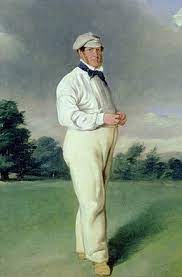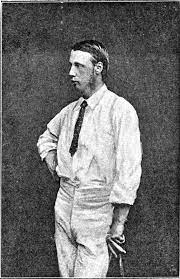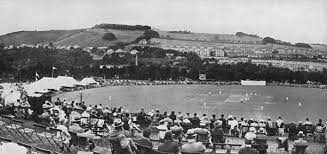I was looking at an early book on Kent cricket, snappily entitled “Kent Cricket Matches 1719 – 1880”, written by Lord Harris and F.S. Ashley-Cooper, the first great cricket statistician, and published by the county club in 1929. I was actually just dusting some of my bookshelves, but that always takes time as soon as you open a book you had half forgotten, and soon I was looking to see how well the county had fared at Canterbury in its first years of playing at the St. Lawrence Ground. In the process I discovered a remarkable fact or two.
The basic truth is that the St. Lawrence Ground was for many seasons not a happy hunting ground for the club. The first match that the Kent county side played at the St. Lawrence Ground was in 1847, when Kent played England, and won by three wickets. A promising start, you might think, with runs for Fuller Pilch and Felix, despite formidable bowling by John Wisden and Lillywhite for England, and plenty of wickets for Hillyer and Alfred Mynn, the ‘Lion of Kent’, who first played for his beloved county in 1834. Kent beat England again the next year, by ten wickets, in a match that caused a marked improvement in cricketing etiquette. As the book records, “This match was finished by Mr. Mynn hitting away the ball, and Parr, instead of throwing it up, ran off with it. This caused an alteration in the custom…. and in future the ball at the conclusion of a match became the property of the umpire, instead of, as before, being scrambled for by the [fielding] side.” These days, the players on both sides scramble for stumps, bails, the ball, shirts, caps and indeed anything that does not require a crowbar to steal.

For several years, the only match the county played at the St. Lawrence Ground was in Canterbury Week against England, but the 1849 encounter, won by Kent by 206 runs, was the last time that Kent beat England there. Kent were at this time regularly playing county matches on other grounds in the county, including Tunbridge Wells, Tonbridge, Faversham, Maidstone, Margate, Crystal Palace, Gravesend, Cranbrook and even Sandgate, but they did not win another eleven-a-side game at Canterbury until 1877. A combined Kent and Surrey eleven (a forerunner of the Oval Invincibles in the Hundred, presumably) beat England at Canterbury in 1855, but that was largely due to the batting and bowling of Caffyn (63 runs and 8 wickets), and he was (for most of his career at least) a Surrey man, born in Reigate. Kent and Sussex beat England by six wickets in the Canterbury Week match the next year, thanks mainly to the bowling of Kent’s own Edgar Willsher (11 wickets) and Sussex man John Wisden (7 wickets). 1860 was a better year – Kent beat a weak “MCC and Ground” side by nine wickets, and then XVI of Kent beat England by an innings, thanks to Willsher’s 8 for 16, and the extra help given by having five extra batsmen. But still no Kent team had won a match on equal terms at Canterbury for over a decade.
The first county v county game at Canterbury was in 1862, when Surrey were the visitors, and they went back to the Oval with an eight wicket victory under their belts. In the first season of the new reorganised Kent County Cricket Club, 1871, the county managed to draw their match against Surrey – what we village cricketers would call a winning draw as Surrey still needed 50 runs with only three wickets left, but still no victory. The game also included a classic village cricket moment, when C.I. Thornton of Kent hit a skier to such a height that the batsmen were able to run two before gravity took the ball towards where Surrey’s H.H. Stephenson, fielding at point, was waiting for the catch. However, despite having had plenty of time to line the catch up, H.H. got it completely wrong and the ball landed a good five yards behind him. Even by village standards, that’s a bad misjudgement, although it is possible that the powerful icy wind, which uprooted several tents at the ground, may have hampered him.

Finally in August 1877, 28 years after they last won a county game at Canterbury, Kent beat Hampshire by six wickets. The winning runs were, fittingly, hit by Lord Harris, who had top scored with 75 in the first innings. This was an era when Lord Harris, still in his twenties, was trying to build a strong Kent side which could challenge for the county championship, but this was also an era when social position counted for at least as much as cricketing skill. Of the team that beat Hampshire, seven were amateurs, and of the 29 men who represented the county that season, only seven – just under one quarter – were professional cricketers. Not that Kent was the only county to follow the social fashions of the time: the Hampshire eleven contained no fewer than nine amateurs.
I’m not sure that things have gone much better for the county at the St. Lawrence headquarters since then. Perhaps that was one reason why Lord Harris was so determined to have a painting immortalising Kent’s innings victory over Lancashire in 1906 – he just didn’t know whether it was ever likely to happen again.
Today we play most of our home matches at Canterbury and our win ratio has improved a bit, but still compared with other home grounds, it is hardly a fortress. According to Howard Milton and Peter Francis’s masterly book on the County Grounds of Kent, to the beginning of 2021, Kent had played 448 first-class games at Canterbury, and won 193 while losing 168 (make that 169 after the Yorkshire game just ended). The remaining 235 were drawn, abandoned or cancelled. If we take out the games with no result, Kent have won 53.3% of games there. The figure for the Mote at Maidstone shows that we have won 64.5% of all completed red-ball matches there, and at The Nevill in Tunbridge Wells the score is 58.8%. In fact, the only ground where Kent have played at least 30 county matches but have a worse win/lose ratio than Canterbury is Dartford, where we have won 9 and lost 8 of our games there – a little under 53% of games won. Let’s get back to Folkestone (67% won), Maidstone (64.5%) or, if only we could, Dover (60.8%).

But it will be too expensive to move home, or to rebuild the Crabble, so the only option is to get better at playing at Canterbury.
0 Comments